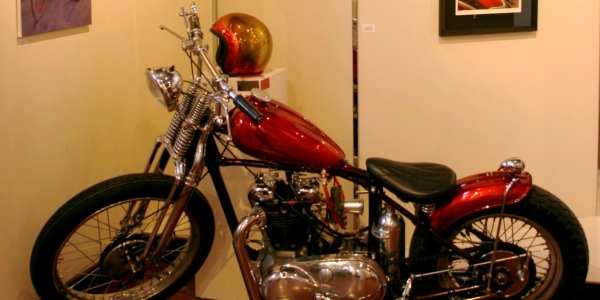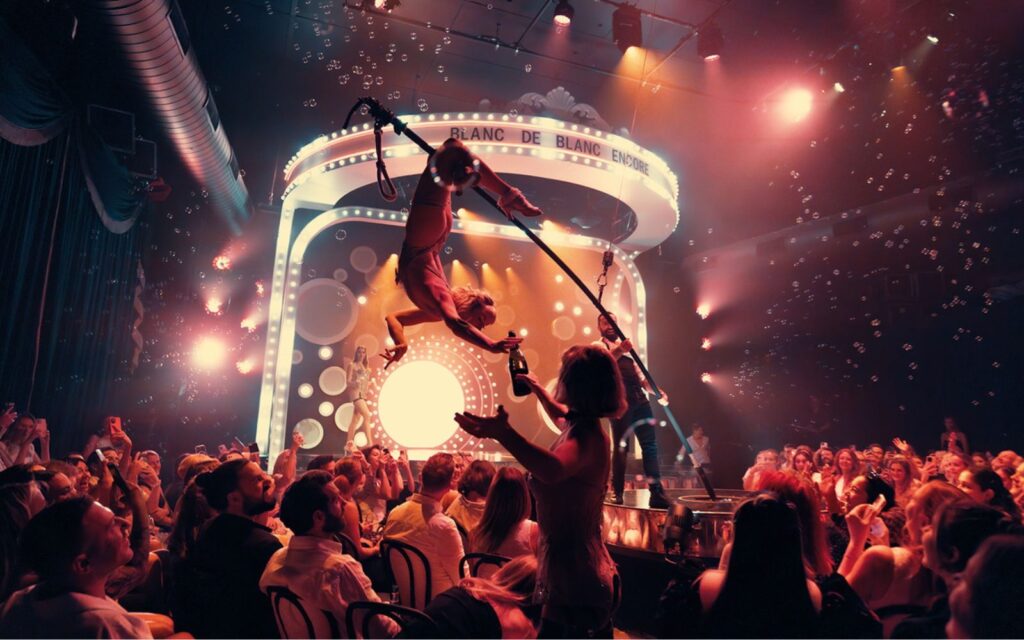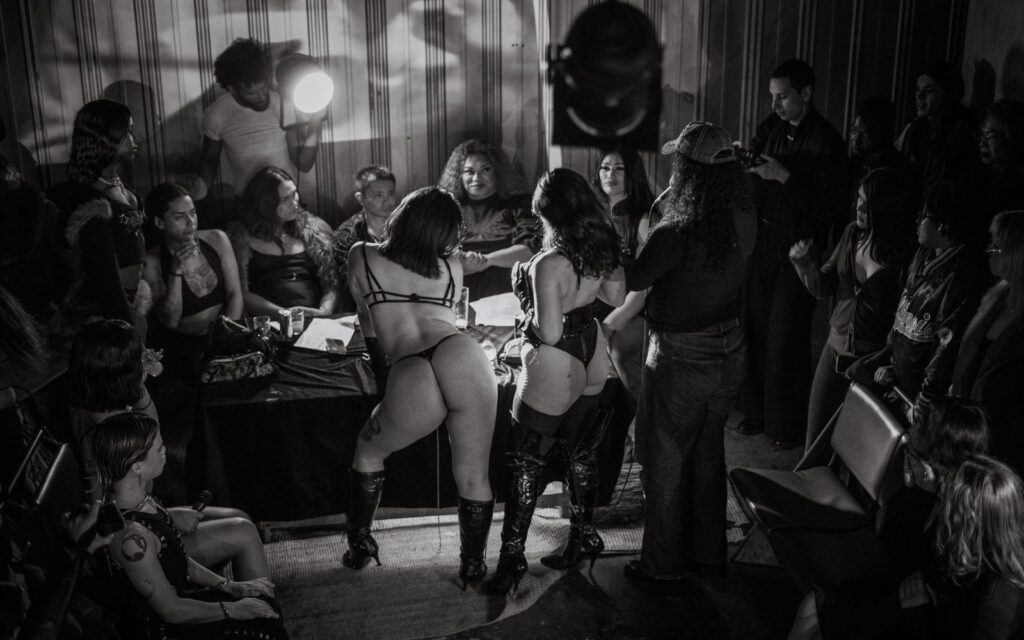“Chops ‘N’ Bobbers is pretty much based around all pre-1975 bikes. So Triumphs, Harleys – that sort of style of bike in that they can either be restored, or generally most of them tend to be modified,” explains curator Tony Peake. “But they’re modified in the traditional way, they’re not modified like a modern day chopper with all these bolt-on bits and pieces, but basically all of the bikes have to be built by the person who owns them. So like they’re all done in the traditional way, so you scrounge and you find bits and pieces and you add stuff onto it, you just don’t ring up a catalogue mob and just bolt a bit on, if you know what I mean.” He explains further. “So we’re reasonably strict on what sort of bikes we put in. We tend to get around about 16-18 bikes in the gallery, and then they are displayed along with complementary artwork, it’s the motorcycle and the art together. The Chops ‘N’ Bobbers means the choppers [modified bikes that have been chopped up], it’s whether they’re a Cafe Racer style thing. Or just a typical street bike that has been restored or whatever it might be. And then we generally get a couple of other guys that have got a, I guess you would call it a ‘barn find’ type bike, which is a bike that has been sitting in someone’s backyard for years and years and years that they have just dragged out and bring it along, and that’s how they found it, if you know what I mean.”
The exhibition evokes a stylish sense of history with a stunning dissection of a classic, time-forlorn, beauty in design. “It gives you a really broad cross section of what was happening in the ’50s, ’60s and ’70s as far as what people did to their bikes during those times. We’ll have an early-style cafe racer, we’ll have an early race bike like a 1942 Harley Davidson that’ll be here on display. As well as all these Triumphs and things like that,” lists Tony with glee. “We’ll have an old Triumph here that was probably built from the mid to late ’60s, all flamed and all that sort of stuff. But all of the paint’s flaking off it – it’s got all of the old original equipment. You probably can’t ride it, but that’s not that point,” he laughs. “The point is to show people what they did back then. So it’s a bit of history lesson, but also to show what can be done you know these bikes are still pretty cool now when they’re restored and done up.”
As well as featuring the motorbikes – which are artworks in themselves – the exhibition will also be garnished by variousworks of art which further enhance the aesthetic of the era. “The artwork that goes with it is the same thing, we have different artists in Melbourne and a few overseas that contribute to the show and then put on an art show as well that goes hand-in-hand with the bikes,” Tony reveals. “The artwork that the guys generally do is old school style, generally photographs or images of old bikes, and then there’s some original artwork as well that goes with it. I try to curate in a way that the artwork complements the bike that’s sitting alongside it, so you’ve got a mixture of both. But the artwork isn’t just in the art that’s on the wall, you know, it’s also in the motorbikes, so there’s that artwork as well. Some of the work, you know we have artists that build bikes as well so there’s that sort of thing too, there’s a cross over between the two. It’s not just purely a motorbike show; it’s a mixture of both. The art might be the canvasses such as acrylics, oils, etc through to prints just depending on what people do. See some people do digital type art, some of it will be acrylics, some of it will be watercolour,” he divulges.
Getting an idea of the type of machines on display, you get the feeling that it presents an antithesis to the likes of American Chopper and their Frankenstein-like creations. “I don’t know if you know the modern day bike now got like a stupidly low forks and you can’t really ride them, all you can do is stick them in a corner and look at them. I guess it’s a reaction in the sense that you don’t have to have a really cool bike and spend $200,000. You can spend $20,000, $10,000, $5,000. It’s what you put into it, and you can still have a good bike, a bike just as good as that mega-dollar one. The only difference is the mega-dollar one generally you can’t ride,” Tony chuffs. “That’s generally what happens with it, so we try to keep it real, that’s all. I mean, this is going to be our fourth show of doing this, we’ve done it for the last three years it’s probably our most popular show as far as attendees go,” Tony reveals. “Over the three to four weeks we’ll probably get a couple of thousand people through. We get bike clubs coming through on the weekends, they’re all interested to see the sort of bikes we have on display and also the art that goes along with it. A lot of people like art from different fields. It’s not just directly pointed at people who are into motorbikes as such; people can just walk in and still enjoy what they see. You don’t have to be particularly into those things to enjoy the show.”
So how is it that these antiquated machines can still have so much appeal? “I think because they’re still alive, as in the bikes are still alive. You know the bikes been around for forty years and the bloke who owns it still rides it, or fifty years old and the person who owns it still rides it. That’s where I think the appeal lies. I don’t think we have any scooters in this year, but in past years we have had Vespas that people still ride,” he recalls. “It’s not stuck in a corner somewhere. When you go to an op shop you see an old bloody school bag and you still pick it up and go, ‘Yeah, I think I can walk around with that. That’s cool.’ I guess it’s in the eye of the beholder, I don’t know,” he laughs.






